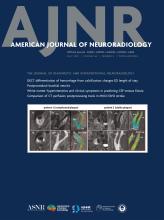This article requires a subscription to view the full text. If you have a subscription you may use the login form below to view the article. Access to this article can also be purchased.
Graphical Abstract
Abstract
BACKGROUND AND PURPOSE: Prolonged venous transit (PVT+) is a marker of venous outflow; it is defined as the presence or absence of time-to-maximum ≥10 seconds timing in either the superior sagittal sinus or torcula. This novel perfusion imaging–based metric has been associated with higher odds of mortality and lower odds of functional recovery. This study aims to assess the relationship between PVT on admission perfusion imaging and length of hospital stay in large vessel occlusion strokes successfully reperfused with mechanical thrombectomy.
MATERIALS AND METHODS: Patients with acute ischemic stroke with large vessel occlusions in the anterior circulation successfully treated with thrombectomy between January 2017 and September 2022 were retrospectively reviewed. The primary outcome was length of stay in the hospital due to the acute stroke event. Univariable and forward stepwise multivariable linear regressions were performed for the primary outcome.
RESULTS: Of 109 patients meeting inclusion, median age was 71 (interquartile range [IQR] 62–80) years. Median hospital length of stay was significantly greater in PVT+ patients (9 [IQR 6–18] days) compared with PVT- patients (6 [IQR 4–12] days, P = .03). In multivariable regression, PVT+ was significantly associated with length of stay, and PVT+ was associated with approximately 2 additional days of hospital stay compared with PVT- (P = .03).
CONCLUSIONS: In successfully reperfused large vessel occlusion strokes, PVT+ was associated with an additional 2 days of hospital stay on average compared with PVT- patients, when adjusting for other clinical covariables. This simple, novel imaging metric is robust in correlating with a range of short- and long-term clinical outcomes.
ABBREVIATIONS:
- AIS-LVO
- large vessel occlusion acute ischemic stroke
- IQR
- interquartile range
- PVT
- prolonged venous transit
- rCBF
- relative cerebral blood flow
- SSS
- superior sagittal sinus
- Tmax
- time-to-maximum
- VIF
- variance inflation factor
- VO
- venous outflow
- © 2025 by American Journal of Neuroradiology













